TCPIP协议族 第四版 第四章答案
《计算机网络(第四版)课后习题答案 谢希仁编著
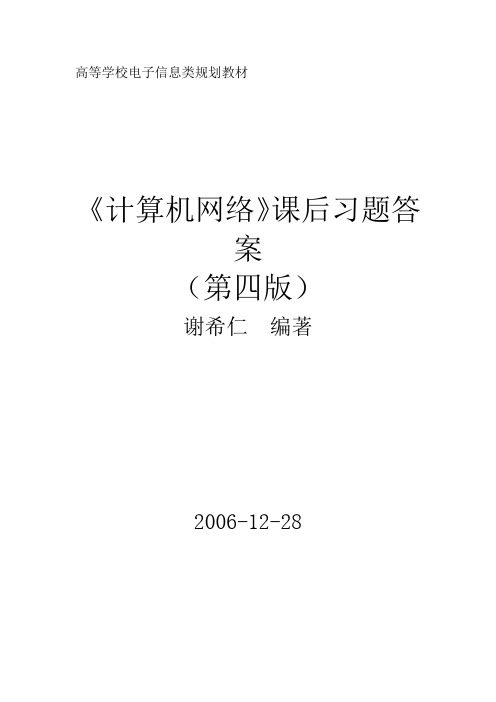
高等学校电子信息类规划教材《计算机网络》课后习题答案(第四版)谢希仁编著2006-12-28第一章概述(P19)1、计算机网络的发展可划分为几个阶段?每个阶段各有何特点?答:计算机网络的发展可分为以下四个阶段。
(1)面向终端的计算机通信网:其特点是计算机是网络的中心和控制者,终端围绕中心计算机分布在各处,呈分层星型结构,各终端通过通信线路共享主机的硬件和软件资源,计算机的主要任务还是进行批处理,在20世纪60年代出现分时系统后,则具有交互式处理和成批处理能力。
(2)分组交换网:分组交换网由通信子网和资源子网组成,以通信子网为中心,不仅共享通信子网的资源,还可共享资源子网的硬件和软件资源。
网络的共享采用排队方式,即由结点的分组交换机负责分组的存储转发和路由选择,给两个进行通信的用户段续(或动态)分配传输带宽,这样就可以大大提高通信线路的利用率,非常适合突发式的计算机数据。
(3)形成计算机网络体系结构:为了使不同体系结构的计算机网络都能互联,国际标准化组织ISO提出了一个能使各种计算机在世界范围内互联成网的标准框架—开放系统互连基本参考模型OSI.。
这样,只要遵循OSI标准,一个系统就可以和位于世界上任何地方的、也遵循同一标准的其他任何系统进行通信。
(4)高速计算机网络:其特点是采用高速网络技术,综合业务数字网的实现,多媒体和智能型网络的兴起。
2、试简述分组交换的特点答:分组交换实质上是在“存储——转发”基础上发展起来的。
它兼有电路交换和报文交换的优点。
分组交换在线路上采用动态复用技术传送按一定长度分割为许多小段的数据——分组。
每个分组标识后,在一条物理线路上采用动态复用的技术,同时传送多个数据分组。
把来自用户发端的数据暂存在交换机的存储器内,接着在网内转发。
到达接收端,再去掉分组头将各数据字段按顺序重新装配成完整的报文。
分组交换比电路交换的电路利用率高,比报文交换的传输时延小,交互性好。
3、试从多个方面比较电路交换、报文交换和分组交换的主要优缺点。
计算机网络课后习题参考答案第四章
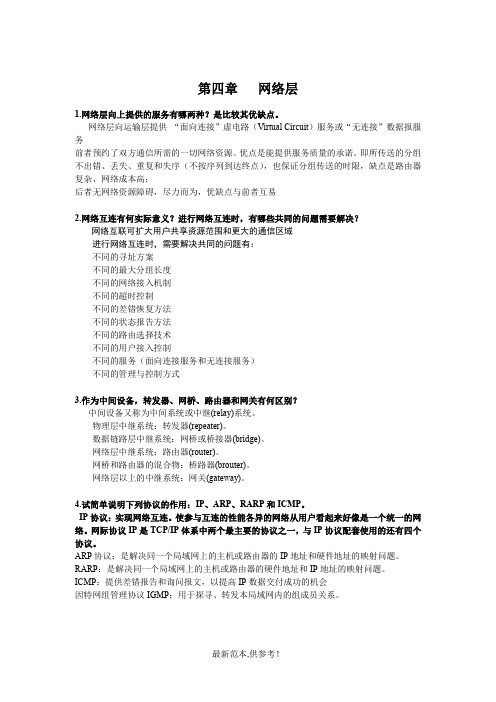
第四章网络层1.网络层向上提供的服务有哪两种?是比较其优缺点。
网络层向运输层提供“面向连接”虚电路(Virtual Circuit)服务或“无连接”数据报服务前者预约了双方通信所需的一切网络资源。
优点是能提供服务质量的承诺。
即所传送的分组不出错、丢失、重复和失序(不按序列到达终点),也保证分组传送的时限,缺点是路由器复杂,网络成本高;后者无网络资源障碍,尽力而为,优缺点与前者互易2.网络互连有何实际意义?进行网络互连时,有哪些共同的问题需要解决?网络互联可扩大用户共享资源范围和更大的通信区域进行网络互连时,需要解决共同的问题有:不同的寻址方案不同的最大分组长度不同的网络接入机制不同的超时控制不同的差错恢复方法不同的状态报告方法不同的路由选择技术不同的用户接入控制不同的服务(面向连接服务和无连接服务)不同的管理与控制方式3.作为中间设备,转发器、网桥、路由器和网关有何区别?中间设备又称为中间系统或中继(relay)系统。
物理层中继系统:转发器(repeater)。
数据链路层中继系统:网桥或桥接器(bridge)。
网络层中继系统:路由器(router)。
网桥和路由器的混合物:桥路器(brouter)。
网络层以上的中继系统:网关(gateway)。
4.试简单说明下列协议的作用:IP、ARP、RARP和ICMP。
IP协议:实现网络互连。
使参与互连的性能各异的网络从用户看起来好像是一个统一的网络。
网际协议IP是TCP/IP体系中两个最主要的协议之一,与IP协议配套使用的还有四个协议。
ARP协议:是解决同一个局域网上的主机或路由器的IP地址和硬件地址的映射问题。
RARP:是解决同一个局域网上的主机或路由器的硬件地址和IP地址的映射问题。
ICMP:提供差错报告和询问报文,以提高IP数据交付成功的机会因特网组管理协议IGMP:用于探寻、转发本局域网内的组成员关系。
5.IP地址分为几类?各如何表示?IP地址的主要特点是什么?分为ABCDE 5类;每一类地址都由两个固定长度的字段组成,其中一个字段是网络号net-id,它标志主机(或路由器)所连接到的网络,而另一个字段则是主机号host-id,它标志该主机(或路由器)。
计算机网络技术 课后习题答案 第4章 计算机网络协议与网络体系结构
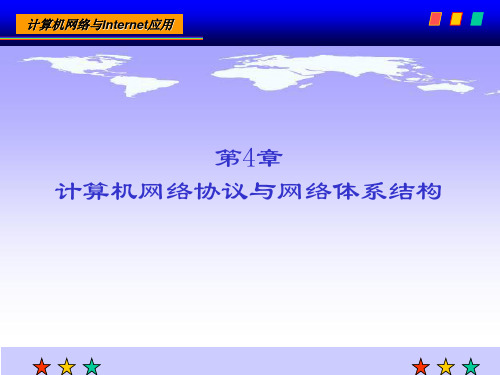
串行比特传输
EIA-232/v.24接口
DTE-B
DCE-A (Modem)
DCE-B(Modem) 13
计算机网络与Internet应用
2、数据链路层
(每步如何走)
数据链路---由实现协议的软硬件加到 物理链路(Link)上,构成可传输帧的 数据链路(右图) 数据链路层主要功能:将从物理层来的
PSN1 Pt PSN2 Pt
原始数据打包成帧,并通过链路管理,
帧传输,流量控制,差错控制,在不太 可靠的物理链路上实现数据帧的无 差错传递。 基本服务:透明传输; 链路管理;帧同步; 差错检测与控制;流量控制;将数据 和控制信息分开;寻址。
Data Frame Buffer Buffer
DataLink Layer
15
计算机网络与Internet应用
4、运输层 (对方在何处) 运输层的任务:负责主机中两个进程之间的逻辑通信.包括: 向高层提供两种服务(连接的和不连接的); 对高层来的数据(报文)分段,为高层应用封装数据; 采用客户机和服务器的端口号标识运行于同一主机内的不同进程,控制 运行于不同主机上的两个进程之间的端到端的通信。 运输层的作用:通过协议屏蔽了互连网中各类通信子网的差异,并以报 文为数据单位进行传送,为以上各层提供运输服务,最终确保端到端的 可靠通信。
17
计算机网络与Internet应用
7、应用层 (做什么) 应用层确定进程之间通信的性质以符合用户的请求;负责用 户信息的语义表示,并在两个通信者之间进行语义匹配。 应用层直接为用户的应用进程提供(无需通过SAD)所需的信 息交换和远程操作,而且还要作为相互作用的应用进程的用户代理,
计算机网络第四版(课后练习答案)
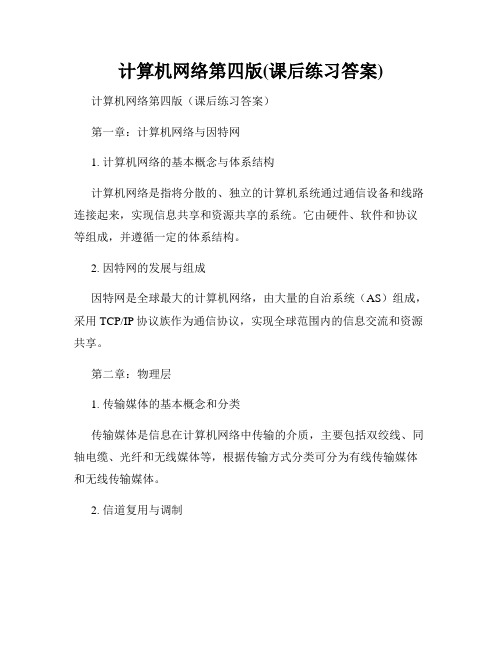
计算机网络第四版(课后练习答案)计算机网络第四版(课后练习答案)第一章:计算机网络与因特网1. 计算机网络的基本概念与体系结构计算机网络是指将分散的、独立的计算机系统通过通信设备和线路连接起来,实现信息共享和资源共享的系统。
它由硬件、软件和协议等组成,并遵循一定的体系结构。
2. 因特网的发展与组成因特网是全球最大的计算机网络,由大量的自治系统(AS)组成,采用TCP/IP协议族作为通信协议,实现全球范围内的信息交流和资源共享。
第二章:物理层1. 传输媒体的基本概念和分类传输媒体是信息在计算机网络中传输的介质,主要包括双绞线、同轴电缆、光纤和无线媒体等,根据传输方式分类可分为有线传输媒体和无线传输媒体。
2. 信道复用与调制信道复用是指多路复用技术,用于将多个通信信道中的数据通过一个物理通道传输。
调制技术是将数字信号转换为模拟信号的过程,常用的调制方式有ASK、FSK、PSK等。
第三章:数据链路层1. 数据链路层的基本概念和功能数据链路层在物理层之上,提供有点到点的数据传输服务,主要功能包括帧的封装与解封装、错误检测与纠正、流量控制和访问控制等。
2. 介质访问控制介质访问控制是指多个计算机节点在共享传输媒体时的竞争与协调机制,主要包括载波侦听、轮询、令牌传递和CSMA等。
第四章:网络层1. 网络层的基本概念与功能网络层是计算机网络中的核心层,负责将分组从源节点传输到目的节点,主要功能包括寻址与路由、分组的转发与接收、拥塞控制和互联互通等。
2. 网际协议(IP)IP协议是因特网中最主要的协议之一,它定义了数据报的格式和传输规则,实现了数据包的路由和转发功能,是因特网的核心协议之一。
第五章:运输层1. 运输层的基本概念与功能运输层负责对网络层传输的数据进行可靠或无需可靠地传输,主要功能包括端到端的连接建立与释放、数据的分段与重组、流量控制和拥塞控制等。
2. 传输控制协议(TCP)TCP是因特网中最重要的运输层协议之一,它提供可靠的、面向连接的数据传输服务,通过确认应答和超时重传等机制,保证了数据的可靠性和可恢复性。
计算机网络第四版习题答案资料

计算机网络(第四版)习题答案第1 章概述1-3 a : ( ) ( ).a . .客户-服务器系统的性能会受到两个网络因素的影响:网络的带宽(每秒可以传输多少位数据)和延迟(将第一个数据位从客户端传送到服务器端需要多少秒时间)。
请给出一个网络的例子,它具有高带宽和高延迟。
然后再给出另一个网络的例子,它具有低带宽和低延迟。
答:横贯大陆的光纤连接可以有很多千兆位/秒带宽,但是由于光速度传送要越过数千公里,时延将也高。
相反,使用56 调制解调器呼叫在同一大楼内的计算机则有低带宽和较低的时延。
1-4 , a a ?除了带宽和延迟以外,针对数字化的语音流量,想要让网络提供很好的服务质量,还需要哪个参数?声音的传输需要相应的固定时间,因此网络时隙数量是很重要的。
传输时间可以用标准偏差方式表示。
实际上,短延迟但是大变化性比更长的延迟和低变化性更糟。
1-6 A a , a 40,000 . a ?一个客户-服务器系统使用了卫星网络,卫星的高度为40000。
在对一个请求进行响应的时候,最佳情形下的延迟是什么?答:由于请求和应答都必须通过卫星,因此传输总路径长度为160,000千米。
在空气和真空中的光速为300,000 公里/秒,因此最佳的传播延迟为160,000/300,000秒,约533 。
1-9 A 2n - 1 a , a . i j a . j. n, .在一个集中式的二叉树上,有21个路由器相互连接起来;每个树节点上都有一个路由器。
路由器i为了与路由器j进行通信,它要给树的根发送一条信息。
然后树根将消息送下来给j。
假设所有的路由器都是等概率出现的,请推导出当n很大时每条消息的平均跳数的一个近似表达式。
答:这意味着,从路由器到路由器的路径长度相当于路由器到根的两倍。
若在树中,根深度为1,深度为n,从根到第n层需要1跳,在该层的路由器为0.50(50%)。
从根到1 层的路径的路由器为0.25(25%)和n2跳步。
计算机网络第四版 习题详细答案

计算机网络习题解答教材计算机网络第一章概述习题1--01 计算机网络的发展可划分为几个阶段?每个阶段各有何特点?答: 计算机网络的发展过程大致经历了四个阶段。
第一阶段;(20世纪60年代)以单个计算机为中心的面向终端的计算机网络系统。
这种网络系统是以批处理信息为主要目的。
它的缺点是;如果计算机的负荷较重,会导致系统响应时间过长;单机系统的可靠性一般较低,一旦计算机发生故障,将导致整个网络系统的瘫痪。
第二阶段;(20世纪70年代)以分组交换网为中心的多主机互连的计算机网络系统。
为了克服第一代计算机网络的缺点,提高网络的可靠性和可用性,人们开始研究如何将多台计算机相互连接的方法。
人们首先借鉴了电信部门的电路交换的思想。
所谓“交换”,从通信资源的分配角度来看,就是由交换设备动态地分配传输线路资源或信道带宽所采用的一种技术。
电话交换机采用的交换技术是电路交换(或线路交换),它的主要特点是;①在通话的全部时间内用户独占分配的传输线路或信道带宽,即采用的是静态分配策略;②通信双方建立的通路中任何一点出现了故障,就会中断通话,必须重新拨号建立连接,方可继续,这对十分紧急而重要的通信是不利的。
显然,这种交换技术适应模拟信号的数据传输。
然而在计算机网络中还可以传输数字信号。
数字信号通信与模拟信号通信的本质区别在于数字信号的离散性和可存储性。
这些特性使得它在数据传输过程中不仅可以间断分时发送,而且可以进行再加工、再处理。
③计算机数据的产生往往是“突发式”的,比如当用户用键盘输入数据和编辑文件时,或计算机正在进行处理而未得出结果时,通信线路资源实际上是空闲的,从而造成通信线路资源的极大浪费。
据统计,在计算机间的数据通信中,用来传送数据的时间往往不到10%甚至1%。
另外,由于各异的计算机和终端的传输数据的速率各不相同,采用电路交换就很难相互通信。
为此,必须寻找出一种新的适应计算机通信的交换技术。
1964年,巴兰(Baran)在美国兰德(Rand)公司“论分布式通信”的研究报告中提出了存储转发(store and forward)的概念。
CP4参考答案

第4章01. 什么是动态、静态、自适应、非自适应、集中式、非集中式、分层次路由选择策略?IGP、IRP、EGP、ERP、RIP、OSPF和BGP与上述概念间的关系?静态/非自适应路由选择策略——用人工配置每一条路由,简单、开销较小,但不能及时适应网络状态的变化。
动态/自适应路由选择策略——不是事先人工配置,而且可随时间/网络状态变化,能较好地适应网络状态的变化,但实现起来较为复杂,开销也比较大。
集中式路由选择策略——建立路由表的计算,由网控中心集中完成,然后分别装入到各节点中。
分布式路由选择策——建立路由表的计算由每个节点计算完成。
分层次路由选择策——大型网络中,网内节点分成若干个区,即形成两层结构。
网再大,还要细分,即形成多层网络结构。
IGP=IRP,RIP、OSPF是IGP的具体实现;EGP=ERP,BGP是EGP的具体实现;IGP、EGP、RIP、OSPF和BGP都是采用的动态(即自适应)、分布式路由选择策略;IGP和EGP可采用分层次路由选择策略同时也构成Internet的两层路由选择策略。
02. RIP2、OSPF和BGP-4在什么时候用什么协议与谁交换什么路由信息?时间 协议 交换站 路由信息RIP2 固定时间间隔 UDP 相邻路由器 路由表(距离向量) OSPF 链路状态发生变化时 IP 所有路由器 相邻路由器的链路状态BGP-4 路由表有变化时 TCP 相邻的BGP发言人路由表变化部分4-2 网络互连有何实际意义?进行网络互连时,有哪些共同的问题需要解决?网络互联可扩大用户共享资源范围和更大的通信区域进行网络互连时,需要解决共同的问题有:不同的寻址方案不同的最大分组长度不同的网络接入机制不同的超时控制不同的差错恢复方法不同的状态报告方法不同的路由选择技术不同的用户接入控制不同的服务(面向连接服务和无连接服务)不同的管理与控制方式4-4 试简单说明下列协议的作用:IP、ARP、RARP和ICMP。
计算机网络第四版参考答案第四章
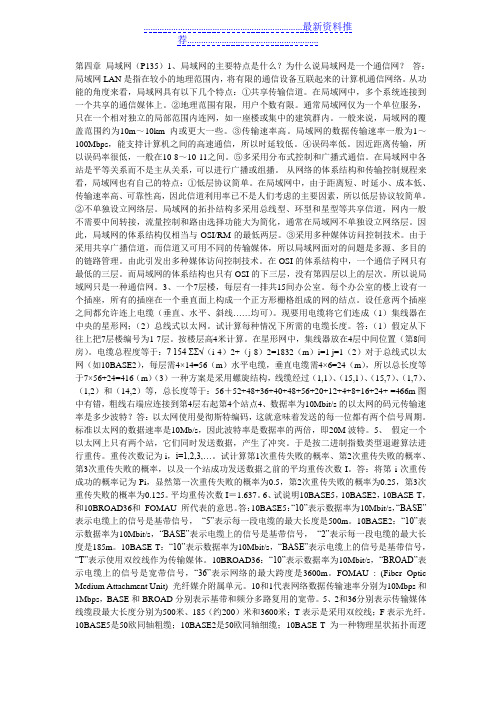
第四章局域网(P135)1、局域网的主要特点是什么?为什么说局域网是一个通信网?答:局域网LAN是指在较小的地理范围内,将有限的通信设备互联起来的计算机通信网络。
从功能的角度来看,局域网具有以下几个特点:①共享传输信道。
在局域网中,多个系统连接到一个共享的通信媒体上。
②地理范围有限,用户个数有限。
通常局域网仅为一个单位服务,只在一个相对独立的局部范围内连网,如一座楼或集中的建筑群内。
一般来说,局域网的覆盖范围约为10m~10km内或更大一些。
③传输速率高。
局域网的数据传输速率一般为1~100Mbps,能支持计算机之间的高速通信,所以时延较低。
④误码率低。
因近距离传输,所以误码率很低,一般在10-8~10-11之间。
⑤多采用分布式控制和广播式通信。
在局域网中各站是平等关系而不是主从关系,可以进行广播或组播。
从网络的体系结构和传输控制规程来看,局域网也有自己的特点:①低层协议简单。
在局域网中,由于距离短、时延小、成本低、传输速率高、可靠性高,因此信道利用率已不是人们考虑的主要因素,所以低层协议较简单。
②不单独设立网络层。
局域网的拓扑结构多采用总线型、环型和星型等共享信道,网内一般不需要中间转接,流量控制和路由选择功能大为简化,通常在局域网不单独设立网络层。
因此,局域网的体系结构仅相当与OSI/RM的最低两层。
③采用多种媒体访问控制技术。
由于采用共享广播信道,而信道又可用不同的传输媒体,所以局域网面对的问题是多源、多目的的链路管理。
由此引发出多种媒体访问控制技术。
在OSI的体系结构中,一个通信子网只有最低的三层。
而局域网的体系结构也只有OSI的下三层,没有第四层以上的层次。
所以说局域网只是一种通信网。
3、一个7层楼,每层有一排共15间办公室。
每个办公室的楼上设有一个插座,所有的插座在一个垂直面上构成一个正方形栅格组成的网的结点。
设任意两个插座之间都允许连上电缆(垂直、水平、斜线……均可)。
现要用电缆将它们连成(1)集线器在中央的星形网;(2)总线式以太网。
TCPIP习题答案

2 c. 每个公司需要 4 个地址,这就表示,后缀长度是 2( 2 4 ) 。因此,前缀长度是 32-2=30.
这些地址是: 第 1 个家庭:150.80.125.0/30-----150.80.125.3/30 第 2 个家庭:150.80.125.4/30-----150.80.125.7/30 …… 第 2048 个家庭:150.80.156.252/30-----150.80.156.255/30 总数 = 2048 × 4 = 8 192 分配给 ISP 的地址数:65 536 ISP 分配出的地址数:40 192 剩下的可用地址数:25 344 11.某 ISP 分配到 120.60.4.0/20 开始的地址块,这个 ISP 想把这些地址分配给 100 个 组 织 , 而每一个组织只分配给 8 个地址。试设计这些地址子块,并给每个子块的斜线记法。经过这 样的分配后,还剩下多少个地址可以使用。 解
d. 掩码 255.255.255.240,比 C 类地址默认掩码(255.255.255.0)多出了 4 个 1,所以子网数 为 2 16 .
4
杭州 电子 。管理员想创建 500 个子网。 5.某组织分配到地址块 16.0.0.0/8 科技 大学 a. 找出子网掩码。 图形 b. 找出每个子网的地址数。 图像 研 c. 找出第一个子网的第一个和最后一个地址。
210 1024 .
b. 掩码 255.255.192.0,比 B 类地址默认掩码(255.255.0.0)多出了 2 个 1,所以子网数为
计算机网络第四版参考答案第四章
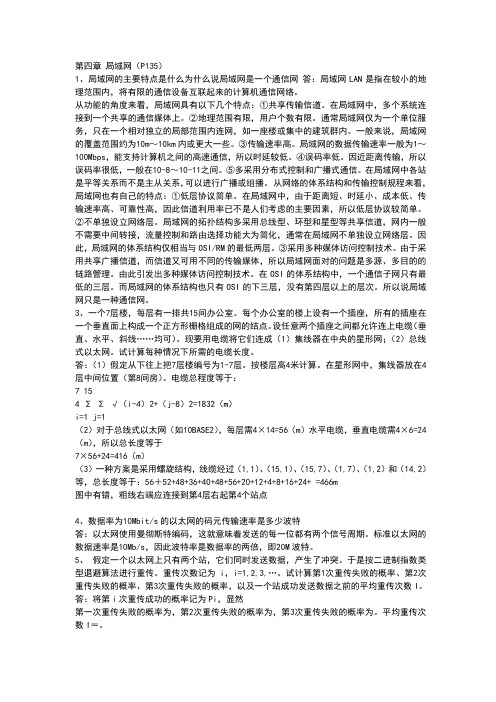
第四章局域网(P135)1、局域网的主要特点是什么为什么说局域网是一个通信网答:局域网LAN是指在较小的地理范围内,将有限的通信设备互联起来的计算机通信网络。
从功能的角度来看,局域网具有以下几个特点:①共享传输信道。
在局域网中,多个系统连接到一个共享的通信媒体上。
②地理范围有限,用户个数有限。
通常局域网仅为一个单位服务,只在一个相对独立的局部范围内连网,如一座楼或集中的建筑群内。
一般来说,局域网的覆盖范围约为10m~10km内或更大一些。
③传输速率高。
局域网的数据传输速率一般为1~100Mbps,能支持计算机之间的高速通信,所以时延较低。
④误码率低。
因近距离传输,所以误码率很低,一般在10-8~10-11之间。
⑤多采用分布式控制和广播式通信。
在局域网中各站是平等关系而不是主从关系,可以进行广播或组播。
从网络的体系结构和传输控制规程来看,局域网也有自己的特点:①低层协议简单。
在局域网中,由于距离短、时延小、成本低、传输速率高、可靠性高,因此信道利用率已不是人们考虑的主要因素,所以低层协议较简单。
②不单独设立网络层。
局域网的拓扑结构多采用总线型、环型和星型等共享信道,网内一般不需要中间转接,流量控制和路由选择功能大为简化,通常在局域网不单独设立网络层。
因此,局域网的体系结构仅相当与OSI/RM的最低两层。
③采用多种媒体访问控制技术。
由于采用共享广播信道,而信道又可用不同的传输媒体,所以局域网面对的问题是多源、多目的的链路管理。
由此引发出多种媒体访问控制技术。
在OSI的体系结构中,一个通信子网只有最低的三层。
而局域网的体系结构也只有OSI的下三层,没有第四层以上的层次。
所以说局域网只是一种通信网。
3、一个7层楼,每层有一排共15间办公室。
每个办公室的楼上设有一个插座,所有的插座在一个垂直面上构成一个正方形栅格组成的网的结点。
设任意两个插座之间都允许连上电缆(垂直、水平、斜线……均可)。
现要用电缆将它们连成(1)集线器在中央的星形网;(2)总线式以太网。
第4章 TCPIP协议族

图4-7
主机 A 广播发送 ARP 请求分组
ARP 请求
ARP协议工作示意图
我是 209.0.0.5,硬件地址是 00-00-C0-15-AD-18 我想知道主机 209.0.0.6 的硬件地址 ARP 请求 209.0.0.5 A ARP 请求 ARP 请求 209.0.0.6 Y B Z
X
00-00-C0-15-AD-18
图4-8 计算机的网间通信
主机 H1 IP1 HA1 硬件地址 HA3 路由器 R1 HA4 局域网 HA5 路由器 R2 HA6 局域网
主机 H2 IP2 HA2
局域网
2.逆地址解析协议RARP
逆地址解析协议 RARP (Reverse Address Resolution Protocol) 使只知道自己硬件地址的 主机能够知道其 IP 地址。这种主机往往是无 盘工作站。 因此 RARP协议目前已很少使用。 这种无盘工作站一般只要运行其ROM中的文件 传送代码,就可用下行装载方法从局域网上其 他主机得到所需的操作系统和TCP/IP通信软件, 但这些软件中并没有IP地址。无盘工作站要运 行ROM中的RARP来获得其IP地址。
4.1.2 ARP与RARP协议
在数据通信过程中,要同时用到逻辑地 址与物理地址,需要实现二者之间的映 射。地址解析协议(ARP)与逆地址解析 协议(RARP)就是来完成逻辑地址与物 理地址的映射任务的。
1.地址解析协议ARP
IP地址是不能直接用来进行通信的。这是因为IP地址 只是主机在抽象的网络层中的地址。若要将网络层中 传送的数据报交给目的主机,还要传到链路层转变为 MAC帧后才能发送到实际的网络上。因此,不管网络 层使用的是什么协议,在实际网络的链路上传送数据 帧时,最终还是必须使用硬件地址。 由于IP地址有32位,而局域网的硬件地址是48位,因 此它们之间不存在简单的映射关系。此外,在一个网 络上可能经常会有新的主机加入进来,或撤走一些主 机。更换网卡也会使主机的硬件地址改变。可见主机 中应存放一个从IP地址到硬件地址的映射表,并且这 个映射表还必须能够经常动态更新。地址解析协议ARP (Address Resolution Protocol)很好地解决了这些问 题。
TCPIP协议族第四版第四章答案
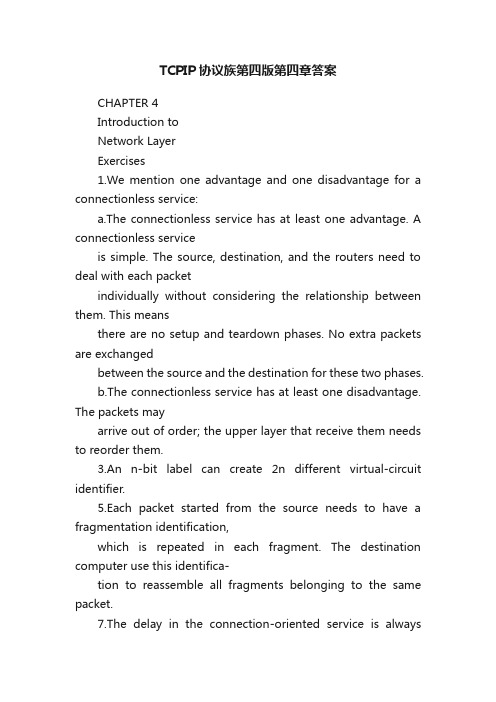
TCPIP协议族第四版第四章答案CHAPTER 4Introduction toNetwork LayerExercises1.We mention one advantage and one disadvantage for a connectionless service:a.The connectionless service has at least one advantage. A connectionless serviceis simple. The source, destination, and the routers need to deal with each packetindividually without considering the relationship between them. This meansthere are no setup and teardown phases. No extra packets are exchangedbetween the source and the destination for these two phases.b.The connectionless service has at least one disadvantage. The packets mayarrive out of order; the upper layer that receive them needs to reorder them.3.An n-bit label can create 2n different virtual-circuit identifier.5.Each packet started from the source needs to have a fragmentation identification,which is repeated in each fragment. The destination computer use this identifica-tion to reassemble all fragments belonging to the same packet.7.The delay in the connection-oriented service is alwaysmore than the delay in theconnectionless service no matter the message is long or short. However, the ratioof the overhead delay (setup and teardown phases) to the data transfer delay (trans-mission and propagation) is smaller for a long message than a short message in aconnection-oriented service.9.A router is normally connected to different link (networks), each with differentMTU. The link from which the packet is received may have a larger MTU than thelink to which the packet is sent, which means that router needs to fragment thepacket. We will see in Chapter 27 that IPv6 does not allow fragmentation at therouter, which means the source needs to do some investigation and make thepacket small enough to be carried through all links.11.A fragment may have been lost and never arrives. The destination host cannot waitforever. The destination host starts a time and after the time-out, it can sends anerror message (see Chapter 9) to inform the source host that the packet is lost and,if necessary, should be resent. The time-out duration can be based on the informa-12 tion the destination host may collect about the status of the Internet. If there are many delays in the previous packetarrivals, it means that the Internet is congested, and the fragment may arrive soon (it is not necessarily lost).。
计算机网络第四版(课后练习+答案)

计算机网络第四版(课后练习+答案)计算机网络第四版(课后练习+答案)Introduction:计算机网络是现代信息技术的基础,它涉及到计算机与计算机之间如何进行数据交换和通信。
《计算机网络第四版》是一本权威指南,提供了大量的课后练习和答案,帮助读者加强对计算机网络的理解。
本文将对《计算机网络第四版》课后练习和答案进行综述,以便读者更好地掌握网络通信的关键概念和原理。
Chapter 1: Introduction to Networking在第一章中,课后练习的内容涵盖了计算机网络的基本概念和发展历程。
学习者可以通过这些练习加深对网络通信的了解,例如描述计算机网络的基本组成部分、定义OSI模型的七层结构以及解释分组交换和电路交换的区别。
Chapter 2: Network Models第二章课后练习着重介绍了计算机网络的各种模型,包括OSI模型和TCP/IP模型。
练习题目涵盖了每个模型的层次结构和功能,同时还要求学习者能够比较这两个模型之间的异同点。
Chapter 3: Physical Layer and Media物理层和传输介质是计算机网络的基础,第三章课后练习起到了巩固和扩展这些概念的作用。
学习者将通过回答问题和解决实际情况的案例,深入理解诸如数据信号的调制和解调、传输介质的特性以及常见的物理层设备等内容。
Chapter 4: Data Link Layer数据链路层构建在物理层之上,并处理节点到节点之间的数据传输。
第四章的课后练习要求学习者熟练掌握数据链路层的基本概念,包括帧的封装和解封装、错误检测和纠正技术以及介绍局域网和广域网等。
Chapter 5: Network Layer网络层负责数据包的转发和路由选择,在第五章的练习题中,学习者需要回答关于IP地址的分配和路由表的设计的问题,深入理解网络层的功能和特性。
还会涉及到IP协议的各种细节,例如子网划分、地址转换和网络控制协议等。
Chapter 6: Transport Layer传输层提供端到端的可靠数据传输服务,第六章的课后练习通过设计案例和讨论问题的方式,帮助学习者掌握TCP和UDP协议的细节和应用场景。
TCPIP协议族4-9131415章标准答案

第4章I4地址:分类编址8.试把以下的IP 地址从二进制记法转换为点分十进制记法。
a..111.1.11..10..0ﻩ0110.1..ﻩ11111101b..100000.ﻩ1111.00.00...101c.ﻩ1.11.0000001111101.11.01d.1111011.ﻩ1.000111ﻩ00011.01e.ﻩ1111.011ﻩ..000111ﻩ1101..01解我们把每一组8 位换成其等效十进制数,并增加隔开的点:a.12...40..03.253b..75.1.2.2...29c..23..76.3...3d...9.247..99.2.e.247.243.1.5.22111.试找出以下.P 地址的netid 和.ostid:a.1.4.34.2.8b..9.....1.5c.2..67.12..d..27.23.4..解以上IP地址都是A 类地址,故前8 位为net..,后24位为hostida..e.id:114ﻩhos.id:.4.2.8.d:19ﻩhostid:34.2..5.d:23hosti.:.7.1..1d..etid:1.7h.stid:23.4.015.试用图表示出:IP 地址为8.0.... 的网络通过路由器连接到I. 地址为.31.45.0.. 的网络。
试为路由器的每一个接口选择.. 地址。
还要在每一个网络上画出几个标有IP地址的主机。
每个网络是什么类别?...IP 地址为..5..7.89.34 的主机需要进行环回测试。
试问源地址和目的地址是什么?解源地址为:.85.67.89.3. 目的地址为:12..x.y.z28.什么是下面每一种情况的最大子网数目?a.A类地址;掩码是255.2.5.1.2.0b.. 类地址;掩码是255...5..92..c.. 类地址;掩码是255..5....5..92d.. 类地址;掩码是255.2.5.2.5..40 解a.掩码.....5...92.0,比A类地址默认掩码(255.0.0.0)多出了10个. ,所以子网数为2.0 .024 .b.掩码2.5...5.192..,比B 类地址默认掩码(2.5...5....)多出了.个1,所以子网数为22 . .c.掩码255.25...5..1.2,比.类地址默认掩码(25..2.5.25..0)多出了2个.,所以子网数为.. 4 .d.掩码255.255.25..240,比C类地址默认掩码(2...2....55.0)多出了.个.,所以子网数为.4 16 .第4章IP地址:无分类编址5.某组织分配到地址块16.0.0.0/8。
tcp,ip协议答案第四版

tcp,ip协议答案第四版篇一:TCP-IP练习题(有答案)一单选题1. OSI模型数据链路层的主要功能是(A)A、利用不可路由的物理地址建立平面网络模型B、通过物理媒体以比特流格式传输数据C、利用逻辑地址建立多个可路由网络D、建立、管理和终止应用层实体之间的会话2. 网络类型号127.x.y.z表示(其中x,y,z表示小于或等于255的一个任意十进制数字)(C)A、一个专用地址B、一个组播地址C、一个回送地址D、一个实验地址3. TCP/IP模型的网络接口层对应于OSI模型的(A)A、物理层和数据链路层B、数据链路层和网络层C、物理层、数据链路层和网络层D、仅网络层4.5.6. IP报头的最大长度是多少个字节(B)A、20 B、60 C、64 D、256 下列哪个协议可提供“ping”和“traceroute”这样的故障诊断功能(A)A、ICMPB、IGMPC、ARPD、RARP 下列对于IP地址的描述不正确的是(A)A、主机部分全为“1”的IP址址称为有限广播B、0.x.y.z表示本网络的指定主机C、一个A类网的IP址址x.0.0.0表示x这个网络D、IP地址172.16.0.0~172.31.255.255属于保留地址7. 下列哪项属于有效的C类IP地址范围(“hhh”表示可分配的主机地址部分)(A)A、192.000.001.hhh ~ 223.255.254.hhhB、192.hhh.hhh.hhh ~ 239.255.255.255C、224.000.000.000 ~ 239.255.255.255D、128.001.hhh.hhh ~ 191.254.hhh.hhh8. 为了确定将数据发送到下一个网络的路径,网络层必须首先对接收到的数据帧做什么(D)A、封装数据包B、改变其IP地址C、改变其MAC地址D、拆分数据包9.10. 从一个C类网络的主机地址借3位时,可建立多少个可用子网(B)A、3B、6C、8D、12 位于同一子网内的每台主机的IP地址满足(B)A、网络部分与主机部分相同B、网络部分与子网部分相同C、子网部分与主机部分相同D、只需网络部分相同即可11. 使用超网(CIDR)技术的主要原因是(C)A、为了去除对子网掩码的需求B、为了扩大路由表的长度C、为了减少路由表的条目D、为了增加额外的B类网络12.13.14. ARP请求作为下列哪种类型的以太网帧被发送(A)TCP在应用程序之间建立了下列哪种类型的线路(A)下列哪项正确地描述了代理ARP(D)A、广播B、单播C、组播D、定向广播A、虚拟线路B、动态线路C、物理线路D、无连接线路A、代理ARP允许一个无盘工作站获取另一个无盘工作站的IP址址B、代理ARP将目的IP地址解析为目的物理(MAC)地址C、代理ARP允许路由器代替本地主机回应ARP请求D、代理ARP允许路由器代替远程主机回应ARP请求15. 在发送TCP接收到确认ACK之前,由其设置的重传计时器到时,这时发送TCP会(A)A、重传重要的数据段B、放弃该连接C、调整传送窗口尺寸D、向另一个目标端口重传数据16. 下列哪项有关UDP的描述是正确的(D)A、UDP是一种面向连接的协议,用于在网络应用程序间建立虚拟线路B、UDP为IP网络中的可靠通信提供错误检测和故障恢复功能C、文件传输协议FTP就是基本UDP协议来工作的D、UDP服务器必须在约定端口收听服务请求,否则该事务可能失败17. 下列哪项最恰当地描述了建立TCP连接时“第一次握手”所做的工作(C)A、“连接发起方”向“接收方”发送一个SYN-ACK段B、“接收方”向“连接发起方”发送一个SYN-ACK段C、“连接发起方”向目标主机的TCP进程发送一个SYN 段D、“接收方”向源主机的TCP进程发送一个SYN段作为应答18. 发送应用程序可以通过设置下列哪两个标志来使TCP进程在传送缓冲器填满前发送数据(B)A、FIL和PSHB、PSH和URGC、UGR和FIND、FIL和FIN19. 下列哪项最恰当地描述了生存时间TTL在IP数据报中的使用(D)A、TTL指出了允许发送主机在线的时间长度B、TTL指出了数据报在一个网段上停留的秒数C、TTL对数据报在一个路由器处等待的时间进行按秒计数D、数据报每经过一个路由器其TTL值就减一20. 下列哪项最恰当地描述了UDP的多路分解过程(C)A、UDP使目标主机将接收到的数据包通过多个IP地址进行路由B、UDP使用IP地址使得多个应用程序在同一主机内同步通信C、UDP使用端口编号使得多个应用程序在同一主机内同步通信D、UDP允许多个主机通过单一虚拟线路进行通信21. 一个数据报被标记为“不可分段”,而这时数据报要通过一个最大传输单元MTU小于该数据报尺寸的网段进行传输,则接下来会发生(C)A、用于传输的网络设备将调节该网段的MTU以适应该数据报的尺寸B、用于传输的网络设备将压缩此数据报以适应该网段的MTUC、用于传输的网络设备将放弃该数据报并通知源结点D、用于传输的网络设备将保留该数据报直到该网段的MTU增大为止22. 为了将几个已经分片的数据报重新组装,目的主机需要使用IP数据报头中的哪个字段(D)A、首部长度字段B、服务类型T oS字段C、版本字段D、标识符字段23. 对于下列给定条件:(1)目的网段的最大传输单元MTU为512字节;(2)一个1500字节的数据报;(3)一个20字节的IP报头。
计算机网络第四版(课后练习+答案)

计算机⽹络第四版(课后练习+答案)第 1 章概述1.假设你已经将你的狗Berníe 训练成可以携带⼀箱3 盒8mm 的磁带,⽽不是⼀⼩瓶内哇地. (当你的磁盘满了的时候,你可能会认为这是⼀次紧急事件。
)每盒磁带的窑最为7GB 字节;⽆论你在哪⾥,狗跑向你的速度是18km/h 。
请问,在什么距离范围内Berníe的数据传输速率会超过⼀条数据速率为150Mbps的传输线?答:狗能携带21千兆字节或者168千兆位的数据。
18 公⾥/⼩时的速度等于0.005 公⾥/秒,⾛过x公⾥的时间为x / 0.005 = 200x 秒,产⽣的数据传输速度为168/200x Gbps或者840 /x Mbps。
因此,与通信线路相⽐较,若x<5.6 公⾥,狗有更⾼的速度。
6. ⼀个客户·服务器系统使⽤了卫星⽹络,卫星的⾼度为40 000km. 在对⼀个请求进⾏响应的时候,最佳情形下的延迟是什么?答:由于请求和应答都必须通过卫星,因此传输总路径长度为160,000千⽶。
在空⽓和真空中的光速为300,000 公⾥/秒,因此最佳的传播延迟为160,000/300,000秒,约533 msec。
9.在⼀个集中式的⼆叉树上,有2n-1 个路出器相互连接起来:每个树节点上都布⼀个路由器。
路由器i 为了与路由器j 进⾏通信,它要给树的根发送⼀条消息。
然后树根将消息送下来给j 。
假设所有的路由器对都是等概率出现的,请推导出当n很⼤时,每条消息的平均跳数的⼀个近似表达式。
答:这意味着,从路由器到路由器的路径长度相当于路由器到根的两倍。
若在树中,根深度为1,深度为n,从根到第n层需要n-1跳,在该层的路由器为0.50。
从根到n-1 层的路径有router的0.25和n-2跳步。
因此,路径长度l为:18.OSI 的哪⼀层分别处理以下问题?答:把传输的⽐特流划分为帧——数据链路层决定使⽤哪条路径通过⼦⽹——⽹络层.28.⼀幅图像的分辨率为1024X 768 像素,每个像素⽤3 字节来表⽰。
计算机网络技术实用教程(第四版)习题答案

计算机网络技术实用教程(第四版)习题答案第一章答案一、名词解释1. 计算机网络答案:计算机网络是将分布在不同地理位置上的具有独立工作能力的计算机、终端及其附属设备用通信设备和通信线路连接起来,并配置网络软件,以实现计算机资源共享的系统。
2. 单播答案:单播是指发送的信息中包含明确的目的地址,所有结点都检查该地址。
如果与自己的地址相同,则处理该信息,如果不同,则忽略3. 组播组播是将信息传送给网络中部分结点。
4. 广播答案:广播是指在发送的信息中使用一个指定的代码标识目的地址,将信息发送给所有的目标结点。
当使用这个指定代码传输信息时,所有结点都接收并处理该信息。
5. 网络拓扑答案:网络拓扑是指计算机网络的物理连接方式叫做网络的拓扑结构。
6. 带宽答案:在通信线路上传输模拟信号时,将通信线路允许通过的信号频带范围称为线路的带宽。
二、填空题1.广域网、城域网、局域网、接入网。
2.广播网络、点对点网络3.单播、组播、广播4.资源子网、通信子网5.汇聚层、接入层6.传输的距离、传输技术、使用的线路、带宽7. 发送时延、传播时延、处理时延三、选择题1-5 BAAAB 6-9DCBB四、简答题1. 计算机网络组成的三要素是什么?答案:一个计算机网络必须具备以下3个基本要素:(1)至少有两个具有独立操作系统的计算机,且它们之间有相互共享某种资源的需求。
(2)两个独立的计算机之间必须用某种通信手段将其连接。
(3)网络中的各个独立的计算机之间要能相互通信,必须制定相互可确认的规范标准或协议。
2. 计算机网络具有哪些功能?答案:计算机网络的功能有:(1)数据通信(2)计算机系统的资源共享(3)进行数据信息的集中和综合处理(4)能均衡负载,相互协作(5)提高了系统的可靠性和可用性(6)进行分布式处理3. 计算机网络的发展可划分为几个阶段?每个阶段各有何特点?答案:(1)具有通信功能的单机系统特点:单机系统中,主计算机负担较重,既要进行数据处理,又要承担通信功能。
计算机网络第四版参考答案第四章
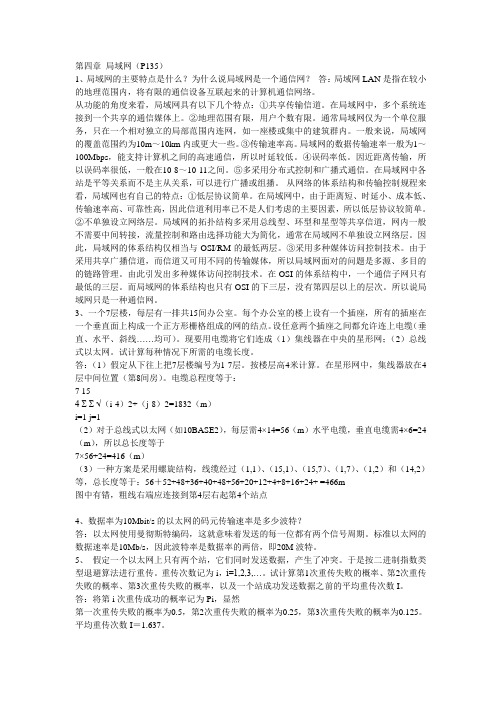
第四章局域网(P135)1、局域网的主要特点是什么?为什么说局域网是一个通信网?答:局域网LAN是指在较小的地理范围内,将有限的通信设备互联起来的计算机通信网络。
从功能的角度来看,局域网具有以下几个特点:①共享传输信道。
在局域网中,多个系统连接到一个共享的通信媒体上。
②地理范围有限,用户个数有限。
通常局域网仅为一个单位服务,只在一个相对独立的局部范围内连网,如一座楼或集中的建筑群内。
一般来说,局域网的覆盖范围约为10m~10km内或更大一些。
③传输速率高。
局域网的数据传输速率一般为1~100Mbps,能支持计算机之间的高速通信,所以时延较低。
④误码率低。
因近距离传输,所以误码率很低,一般在10-8~10-11之间。
⑤多采用分布式控制和广播式通信。
在局域网中各站是平等关系而不是主从关系,可以进行广播或组播。
从网络的体系结构和传输控制规程来看,局域网也有自己的特点:①低层协议简单。
在局域网中,由于距离短、时延小、成本低、传输速率高、可靠性高,因此信道利用率已不是人们考虑的主要因素,所以低层协议较简单。
②不单独设立网络层。
局域网的拓扑结构多采用总线型、环型和星型等共享信道,网内一般不需要中间转接,流量控制和路由选择功能大为简化,通常在局域网不单独设立网络层。
因此,局域网的体系结构仅相当与OSI/RM的最低两层。
③采用多种媒体访问控制技术。
由于采用共享广播信道,而信道又可用不同的传输媒体,所以局域网面对的问题是多源、多目的的链路管理。
由此引发出多种媒体访问控制技术。
在OSI的体系结构中,一个通信子网只有最低的三层。
而局域网的体系结构也只有OSI的下三层,没有第四层以上的层次。
所以说局域网只是一种通信网。
3、一个7层楼,每层有一排共15间办公室。
每个办公室的楼上设有一个插座,所有的插座在一个垂直面上构成一个正方形栅格组成的网的结点。
设任意两个插座之间都允许连上电缆(垂直、水平、斜线……均可)。
现要用电缆将它们连成(1)集线器在中央的星形网;(2)总线式以太网。
tcpip协议族习题答案

tcpip协议族习题答案TCP/IP协议族是互联网的基础,它定义了在网络中传输数据的规则和标准。
以下是一些常见的TCP/IP协议族习题及其答案,供学习参考。
题目1:TCP和UDP协议的主要区别是什么?答案:TCP(传输控制协议)是一种面向连接的协议,它在传输数据之前需要建立连接,并确保数据的可靠传输。
TCP提供流量控制、拥塞控制和错误恢复机制。
UDP(用户数据报协议)则是一种无连接的协议,它不保证数据的顺序、完整性或可靠性,适用于对实时性要求高的应用,如语音和视频通信。
题目2:解释IP地址和MAC地址的区别。
答案:IP地址是网络层的地址,用于在互联网上标识设备的位置,它是一个逻辑地址。
每个IP地址由一系列数字组成,通常分为IPv4和IPv6两种格式。
MAC地址则是数据链路层的地址,用于标识网络接口卡(NIC),是一个物理地址。
MAC地址是设备制造商在生产时分配的,全球唯一。
题目3:DNS服务的主要作用是什么?答案:DNS(域名系统)服务的主要作用是将域名转换为IP地址。
用户通常通过域名来访问互联网上的资源,而设备之间的通信则需要使用IP地址。
DNS服务通过查询域名对应的IP地址,使得用户无需记忆复杂的数字地址。
题目4:简述TCP三次握手过程。
答案:TCP三次握手过程是建立一个可靠的连接所必须的步骤。
第一次握手是客户端发送一个SYN(同步序列编号)标志的数据包到服务器,并指定客户端的初始序列号。
第二次握手是服务器响应客户端的SYN,并发送一个SYN-ACK(同步和确认)标志的数据包,同时指定服务器的初始序列号。
第三次握手是客户端发送一个ACK(确认)标志的数据包到服务器,确认收到服务器的SYN-ACK。
题目5:什么是NAT技术?答案:NAT(网络地址转换)技术是一种用于在私有网络和公共网络之间共享一个IP地址的方法。
它允许多个设备共享单个公网IP地址,从而减少IP地址的消耗,并在一定程度上提供网络安全。
- 1、下载文档前请自行甄别文档内容的完整性,平台不提供额外的编辑、内容补充、找答案等附加服务。
- 2、"仅部分预览"的文档,不可在线预览部分如存在完整性等问题,可反馈申请退款(可完整预览的文档不适用该条件!)。
- 3、如文档侵犯您的权益,请联系客服反馈,我们会尽快为您处理(人工客服工作时间:9:00-18:30)。
CHAPTER 4
Introduction to
Network Layer
Exercises
1.We mention one advantage and one disadvantage for a connectionless service:
a.The connectionless service has at least one advantage. A connectionless service
is simple. The source, destination, and the routers need to deal with each packet
individually without considering the relationship between them. This means
there are no setup and teardown phases. No extra packets are exchanged
between the source and the destination for these two phases.
b.The connectionless service has at least one disadvantage. The packets may
arrive out of order; the upper layer that receive them needs to reorder them.
3.An n-bit label can create 2n different virtual-circuit identifier.
5.Each packet started from the source needs to have a fragmentation identification,
which is repeated in each fragment. The destination computer use this identifica-
tion to reassemble all fragments belonging to the same packet.
7.The delay in the connection-oriented service is always more than the delay in the
connectionless service no matter the message is long or short. However, the ratio
of the overhead delay (setup and teardown phases) to the data transfer delay (trans-
mission and propagation) is smaller for a long message than a short message in a
connection-oriented service.
9.A router is normally connected to different link (networks), each with different
MTU. The link from which the packet is received may have a larger MTU than the
link to which the packet is sent, which means that router needs to fragment the
packet. We will see in Chapter 27 that IPv6 does not allow fragmentation at the
router, which means the source needs to do some investigation and make the
packet small enough to be carried through all links.
11.A fragment may have been lost and never arrives. The destination host cannot wait
forever. The destination host starts a time and after the time-out, it can sends an
error message (see Chapter 9) to inform the source host that the packet is lost and,
if necessary, should be resent. The time-out duration can be based on the informa-
1
2 tion the destination host may collect about the status of the Internet. If there are many delays in the previous packet arrivals, it means that the Internet is congested, and the fragment may arrive soon (it is not necessarily lost).。
